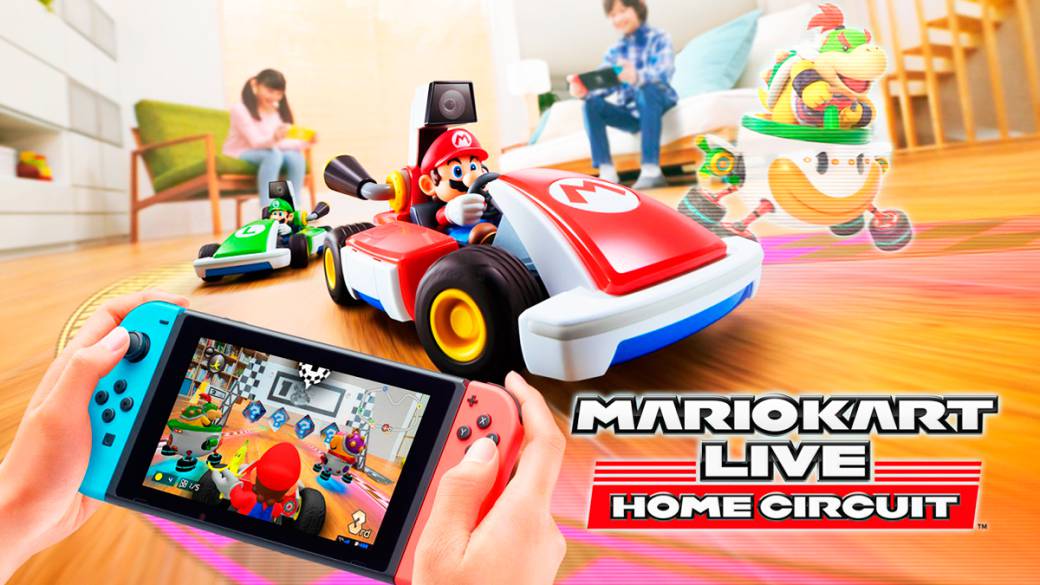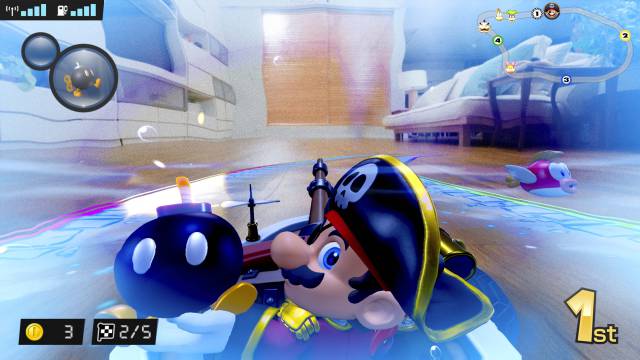
During the last week we have been with the latest idea of Nintendo: mixing the virtual world of Mario Kart with circuits in our house. The result: a sweet toy for the little ones, although somewhat limited for the older ones.
One of the great surprises that the 35th anniversary of Mario Bros left us was the announcement of Mario Kart Live Home Circuit, a strong commitment to augmented reality in which we could control a real kart, remotely from Nintendo Switch while on screen we competed Featuring Bowser’s minions with custom circuits, House Signature items, and more. A tremendously attractive idea on paper, and that when executed works quite well, although it has its limitations.
The first surprising thing about the new Nintendo gadget is the ease with which everything connects. The box brings with it a small physical Mario Kart – don’t expect the size of the remote control karts that go at full speed and that are sold in toy stores -, a USB-C cable and some elements to create the tracks. Basically four doors, which are the ones that will mark the control points of the circuits that we carry out, and a couple of direction signs. Taking into account the eye-catching of these posters, which come out full of lights on the Switch screen, surely it would not have been bad to have some more.

Once we’ve got everything out of the box, it’s time to plug it in. To do this, we need to download the game app -free- on Nintendo Switch, to later link our Kart (it can be Mario or Luigi) in a simple way: pointing the Kart’s camera at the QR code that appears on the game screen. When we have everything ready, we can launch ourselves to play with the title. The first of all will be to create a custom circuit. This is achieved by placing the doors in the areas that we consider inside our house (always indoors) in a physical way and, once done, go to the console, where Lakitu will tell us to place ourselves in front of the first door, he will paint the wheels and we can trace the path we consider, which can have the curves and straights we want, but it always has to go through the inside of the four doors.
This is where we find one of the first limitations of the game itself: coverage. The kart is connected by WiFi with Nintendo Switch, and is sensitive to interference if we have other devices connected. In addition, the radius of action is about five meters, and if there is an obstacle (such as a wall) in between, the connection suffers. Therefore, it is recommended to create the circuits in the same space and play with the console near the track, something that will limit us if you want to play from the television (which is possible).
In any case, once our first circuit is designed, we can start racing against Bowser’s minions. The test is carried out as in a Mario Kart of a lifetime: there will be objects of all kinds, turbos and some obstacles usually linked to the doors (for example, a magnet that drags us, a piranha flower or an electrifying sphere). Whenever we want, we can change the layout of the circuit, create another one again and experience it in the different displacements: 50 and 100 unlocked at the beginning, 150 and 200 when we get new trophies and a surprising mirror mode.
To collect trophies we have to participate in different cups: eight in total with three circuits each, and which must be overcome in all displacements to complete the game 100%. Before starting each glass, some strokes are suggested to us to draw, or simply make one entirely our own. When we finish the first of the tracks, we can design the next one from scratch or keep the same design for the three circuits of each cop. What then changes? The experience from Nintendo Switch, basically.
Each track has its peculiarities in the form of augmented reality. From racing in the water to doing it in the middle of the snow, or with a strong wind in the desert. The visual experience on the console changes and so do the obstacles. If we play a track with a strong blizzard, our physical kart will notice that it is pushed to the side and we will have to correct it while driving. If blocks of ice appear in the middle of the track, we will have to avoid them because if not, the kart will stop short. The relationship between what happens on screen and what happens in the real world is bi-directional: virtual elements affect the physical world, but physical obstacles will also affect us on screen.
One of the graces of Mario Kart Live Home Circuit is precisely generating our own physical obstacles. The legs of a table, a chair, stuffed animals, dolls, cardboard elements … We can let our imaginations fly with all kinds of elements that will harm us. Of course, at least for the moment the layout of the circuit often ends up being modified and generating some problems. For example, on more than one occasion we have made a layout that goes around some table legs… But the game places the layout with those legs in the middle, with the problem that this implies. It has detection errors in this regard with some elements.

With the design of the circuits, in addition to the coverage distance and this setback with some structures, we cannot imagine doing any great feats either. For example, ramps are not detected properly and, in fact, depending on how a ramp is, the car will not have enough power to climb it. In general, our feeling is that the basis for designing and creating circuits is good, but somewhat limited and we cannot let our imagination run wild as much as we would like. On the one hand, the customization options for the races are quite powerful and we are going to have a series of Augmented Reality elements and effects that are very worthwhile. To this is added that although the speed of the Kart is somewhat low at 50 and 100, it is ideal for the smallest of the house and increases significantly in 200. But on the other hand, the physical design cries out for more creative freedom, something that due to the technology itself, it does not always happen.
An ideal toy for the little ones
The experience with the circuits of the predefined cups -or playing against the clock- and the circuits created by us, once we take into account all the premises explained, is satisfactory, especially for the little ones. The race pace, the customization with “his toys” and the concept of creating circuits fit the bill. At home, for example, the two little girls (4 and 6 years old) have been much more hooked playing this Live Home Circuit than not Mario Kart 8. There is also the reason to see each other on the circuits while one plays and vice versa.
For the elderly, as we said, the experience may fall a bit short, although we already warned that Bowser’s henchmen, Bowsy Jr and company are not easy at all, and they demand – with a high dose of injustice in many moments – theirs if we want to unlock all the cups and win them in the different displacements. The control is very simple: button to accelerate, button to brake, launch objects (with some limitations, such as not being able to leave an object such as a banana or a shell attached to the rear of the vehicle) and even use, in a somewhat more simplified, the drifts that naturally have an effect on the real kart: you see how he accelerates live and direct.

Beyond the competition, the game has a collecting aspect that gives the coins some meaning. When we finish a race, the coins are used to unlock new vehicles, new costumes for Mario and Luigi and new accessories, such as the horns. And there are quite a few, it must be said. And it is more than attractive to see Mario dressed as Santa Claus, or Mario Maker, while driving a battle ship or a tractor. Added to this is the fact that overcoming the different competitions allows us to unlock objects, items and elements to customize our own races. To which we have obtained several elements, we can make circuits full of options, something that is appreciated and extends the useful life of the product.
For multiplayer, note that the title allows up to four Karts at the same time, which need their respective four Nintendo Switch. In this sense, the investment to play it at home is not small, since the recommended price is around 99.99 euros, counting that you have a Switch for each one, of course.

conclusion
Mario Kart Live Home Circuit presents a powerful idea, designed to be a success in Christmas shopping. The approach of playing with a real Kart, through Nintendo Switch with Augmented Reality and virtual elements that affect the gameplay (and the real world) is more than attractive. Being able to build our own circuits at home, another point in favor. In addition, it brings with it a lot of content in the form of cups, time trial mode and a large number of unlockables that make it very replayable. But it is also true that the experience is somewhat hampered by its limitations: the coverage of five meters becomes scarce, and sometimes we find problems in the layout of the circuits, which are out of place due to the presence of structures in the house itself, such as the legs of a table, or a console visibility that can be improved depending on the type of light we use. The design of circuits also has its limitations, so it will be time to let your imagination fly for later. In the end, we are left with the feeling that it is a real candy for the little ones in the house, who will enjoy the proposal in all its aspects. Although, yes, for the elderly it may fall a bit short in the long run.

